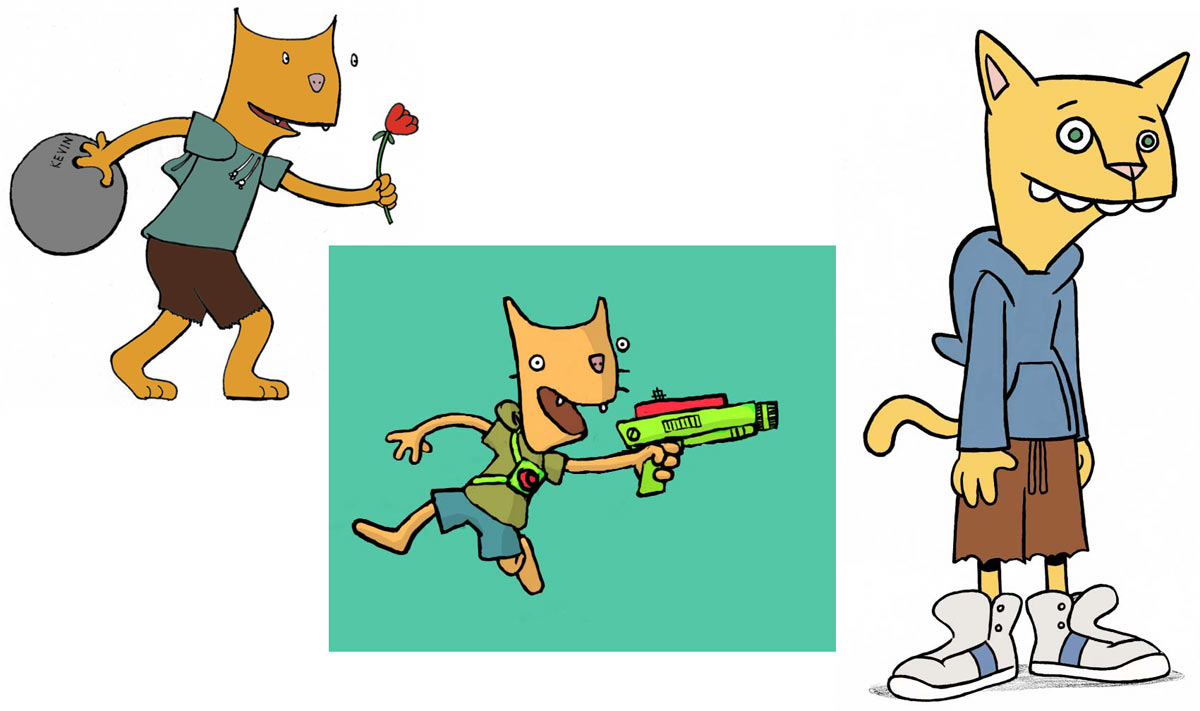

The Upstate Four: An Interview with Fran and Will Krause
.
The Upstate Four (viewable in two parts above) is an eleven-minute Cartoon Network pilot created by brothers Fran Krause and Will Krause. When I first saw it last year, I was immediately taken by the quality of the production. Funny and fresh, energetic and entertaining, it looks and feels like nothing else currently out there. On top of that, the character animation is handled beautifully with none of the corner-cutting that has become an unfortunate hallmark of contemporary Flash TV animation.
The pilot wasn’t picked up for series production and languished at Cartoon Network, but the brothers Krause received recognition for their efforts in the form of a top prize for Children’s Television Animation at the Ottawa International Animation Festival as well as an Excellence in Animation prize from the 2008 ASIFA-East Animation Festival.
The Krause’s pilot for The Upstate Four raises the bar for TV animation everywhere, and proves that, with thoughtful planning and execution, top-grade TV animation is within reach. I wanted to learn how such an inspired and quality piece of work made it through the moribund development pipeline at Cartoon Network. The interview below was conducted via email, and in our far-ranging conversation, Fran and Will guide us through the tangled development process, their feelings about pitching, whether the type of quality they achieved in this pilot could be maintained in regular series production, and some of the lessons they learned from creating this pilot.
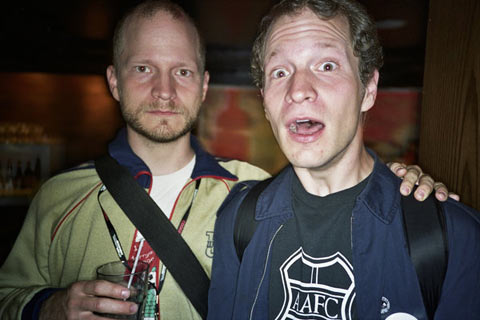
Fran (left) and Will Krause
Amid Amidi: Can you talk a little bit about the development process. How long did it take? What did it entail? For example did you start by pitching a bible or a storyboard?
Will Krause: “Utica Cartoon” (2001) was our first pilot [for Cartoon Network], and it went from pitch to pilot very quickly. I think we first pitched the show in the spring of 2000 and we were working on the pilot by the winter of the same year – I remember our cars kept getting stuck in the icy parking lot of our studio. “Utica Cartoon” was my first professional animation work, and I enjoyed working on the project so much that I wanted to make sure that if it wasn’t chosen to become a series that we’d still be able to keep the studio busy with work. I drew up some drawings of the four characters for what was then called “The Sam Andwich Show,” along with some brief character descriptions and story ideas – a paragraph or so for each – and sent this pitch off to Cartoon Network. The pitch wasn’t too developed at the time, and I think they didn’t want to give more than one pilot to a bunch of inexperienced animators, so they passed.
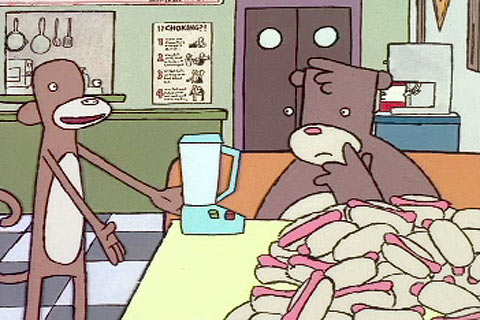
“Utica Cartoon,” a Cartoon Network pilot completed in 2001.
Fran Krause: Now, I don’t mean to trash-talk “Utica Cartoon.” I’m very happy with it. But in retrospect, it wasn’t made with kids in mind. It was made for four 22-year-old recent art-school grads working out of Providence. After we lost “The Big Pick” we watched it again and thought, Why the hell did we start a cartoon off with two charcters playing a board game?!?!
At the time, Kids Next Door was a big success, and everyone wanted shows about kids, so Will and I decided to try making a cartoon that people would actually want. We made a pitch for a show called “PS 123” about three kids. I’m pretty sure Dan Bear had a cameo. Cartoon Network started funding development of a bible and boards, and we worked on that for about two years. Boards for a pilot episode were completed, but the project was canceled before pilot production started. I think this was after the transition from Linda Simensky to Heather Kenyon in 2003.
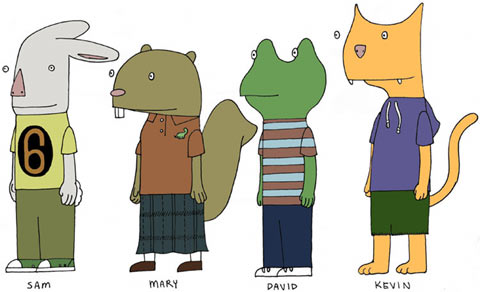
Will Krause’s first drawings of “The Sam Andwich Show” ca. 2002. This eventually became “The Upstate Four.”
Will: I’d added a bit to “The Sam Andwich Show” since I’d first showed the beginnings of a pitch to Cartoon Network, and Fran and I reworked it and showed it to the new people at CN. As the pitch was developed it went from a simple two pages with one group shot of the characters to sixteen pages of writing and images. We wanted to make sure that Cartoon Network had a good idea of what our show would look like in its finished form, so we included drawings of the characters and lots of story descriptions, so that we could prove to them that we wouldn’t run out of ideas.
Fran: Well, Heather looked at all our stuff, liked “Sam Andwich,” and wanted us to try another bible, so we dusted “Sam” off and started expanding it. We started pitching it again, and between 2003-2006 Heather went through, I think, three hundred different bosses at Cartoon Network. You can ask her the exact number. Since all new bosses kill all previous boss’s projects, as an alpha lion kills the previous alpha lion’s cubs, Heather was waiting to see if any of her bosses would last more than a year. In this time, Will and I completed the bible and all the story outlines, but didn’t have a contract.
Will: I think that it was in 2004 or 2005 that our bible was optioned by Cartoon Network. CN decided to get us one person who would act as our advisor and interpreter between ourselves and CN, and we started working with our old friend Tom Warburton, who made Kids Next Door for, like, seven seasons. We spoke with CN and showed them six of the story ideas that we liked the most, written out as page-long outlines, and we agreed with them that the Girl Scout Cookie episode should be the pilot. The development process went on for quite a while, so that Cartoon Network had to extend the option period in our contract a few times. The pace was such that we had to treat pitching as a hobby. Luckily both of us never lost all hope simultaneously, so one of us could always give a pep talk.
Fran: Heather had used up all possible bosses and so was promoted to be the head of development. We finally got a contract to make a bible, outlines, and boards. Since we had already made the bible and outlines, we got to start right away on boards, which were mainly done by the great Jesse Schmal.
Will: Jesse’s boards went through several rounds of revisions that led to lots of scrapped pages. (Moral: keep the board very loose until it gets approved!)
Fran: After a year of legal contracts and board revisions, we were approved to go ahead with a pilot in early 2007. As it turned out, the pitch became less about Sam and more about the group of four animals, so we had to change the name. I think we sent Heather and Alex Manugian a list of three hundred show names. The last hundred were pretty surreal and inappropriate. Heather decided on “The Upstate Four”, but after all that pitching they could have called the show “Fran is an Assmunch” and I would have directed it.
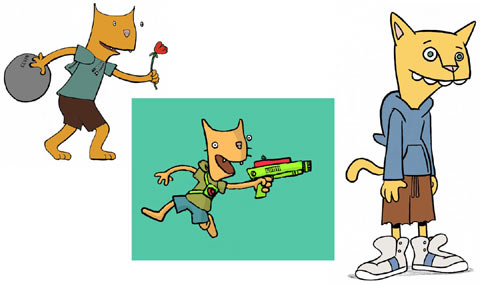
The design process for two of the characters–Kevin (top) and Sam (bottom). The drawings are by, left to right, Will Krause, Fran Krause, and Jesse Schmal. Click on the images for larger versions.

It’s hard to believe such a simple idea went through such a long gestation process. Now, I read on Will’s site that all the BGs were drawn directly into the computer. Is the same true of the animation? Was it an entirely paper-less production?
Fran: No trees were killed in the production of this cartoon. We did everything with Flash, Photoshop & After Effects directly into Cintiqs.
Will: I don’t remember using paper at all on this project, other than doodles in my sketchbook. I even did most of my research into the architecture of Utica, and gathering images of textures that I used in my backgrounds on the Internet – no hauling around library books.
Fran: Will had a book called “Utica: A City Worth Saving” that was filled with photos of old buildings from our home town. I think it came in very handy on the BGs for “Upstate Four.”
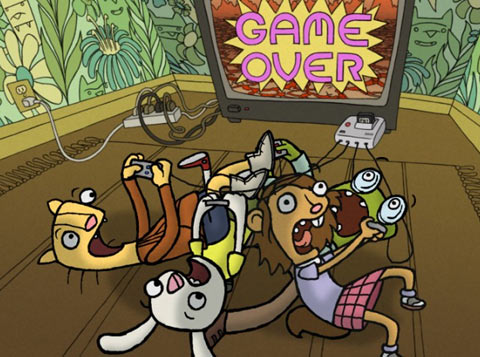
Describe the animation process a bit. Like Superjail, a Flash-animated series that both of you worked on, Upstate Four is refreshingly free of the Flash shortcuts that we’re so used to seeing nowadays. It feels more like a traditionally animated cartoon than Flash. Would it be budgetarily possible to maintain this level of quality throughout the entire run of the series?
Fran: It would definitely be possible – it’s what was done on Superjail, though the workflow was different. We started with an animatic of the boards, from which the key animators based their layouts and Will started the backgrounds. I tried to key out as much as possible to keep the style consistent. From there, it went to the animators to rough out the movement. The assistant animators handled the clean-up and lipsync, and the interns covered the in-betweens and coloring. Shadows were also blocked in with Flash. The scenes were composited in AfterEffects, at which point the camera moves and shadows were added. Oh! Also, this cartoon wa produced entirely in the USA! No outsourcing whatsoever! In fact, except for the music, which was composed and recorded in LA, the entire production, animation, voices and sound were completed in New York.
Will: We wanted to make a modern cartoon within our budget that didn’t look cheap. We had both worked with Flash on other projects and we’d learned a few tricks to make Flash produce animation that didn’t look like a web banner ad for home mortgages, like turning down paintbrush smoothing and avoiding motion tweens. “Utica Cartoon” was traditionally animated, and we figured that since we didn’t have to spend money on paint, film, cels, photocopying, re-registering, etc… that we could spend more time making full animation. Being animators ourselves, we wanted to get the project done without outsourcing since we figured that each job that wasn’t outsourced would lead to hiring another one of our skilled friends. New York is chock-full of animators that I would be psyched to work with.
Fran: I also have to add that the image alone can’t keep a production from looking cheap. The voices and music blew me away. The voice actors were all wonderful to work with and added a ton to the project. They’re creative and hilarious. They were a big factor in keeping this project from looking “Flashy.” The musicians, Miles Kurosky and Nik Freitas created about twenty-eight different songs to fill eleven minutes. I think there’s only about fifteen seconds that don’t have music. Not many cartoons these days have all real live instruments and real live musicians.
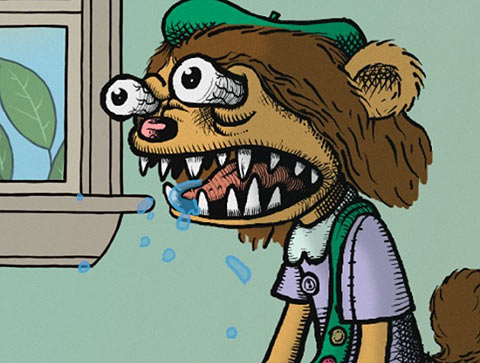
What were the biggest challenges that you faced along the way in the development of the cartoon, both between yourselves developing the project, and external challenges from the network?
Fran: I’d say the biggest challenge in pitching a cartoon is staying fresh and enthusiastic while dealing with “the industry.” It’s hard to keep from becoming a bitter old cynic. The problem is that the goals are different. We want to make a cartoon. They want to make money. There’s some overlap. We want money. They want cartoons. Then there’s arguments. “We just want to make a cartoon!” “But how do we know it can make money?” Also, it’s tough pitching a cartoon with no “hook.” We wanted to say, “our hook is that it’s funny!” but it would have been much easier if they had been secret agents, or one of them was a secret gay. And that’s where the cynicism comes in.
The frustrating part was mainly waiting for legal and development people to agree on everything. To be honest, Cartoon Network was good to work with while we were in production. Once we started production we had almost no notes or changes. Also, the few notes we did have were mostly ignored and not noticed on the final delivery.
Will: It can be hard to stay focused on long-term goals during the development process, with lots of people giving suggestions on how your project can be revised that would carry it in different directions. I had to keep in mind that however our project was altered along the way it always had to be a project that I would be happy to work on. If you can’t be happy working on your own cartoon, why bother pitching?
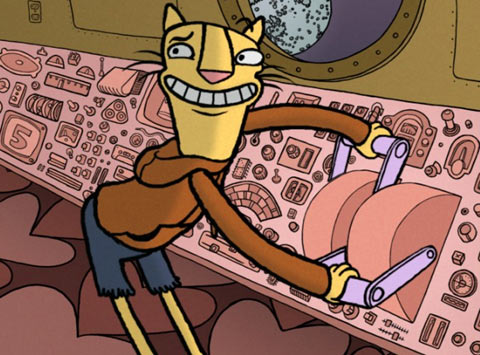
Is the way you developed this cartoon the best way to develop an animated TV series? If not, what would you change about the process?
Fran: No, it was not. The main problem, as I see it, is that over seven years of development, there was a whole lot of money spent. I’d guess somewhere around half a million. In the end, there is just one eleven-minute pilot that is not aired. Consequently, the network is very, very cautious and slow with the production of each pilot. Also, the eleven minute pilot doesn’t really tell much more about the show than, say, an eleven minute animatic with one minute of animation that could be completed for one-tenth the cost.
Will: I agree on this one – there is a communication problem between animators and development executives, and there should be less time and money consuming methods to get a show idea across other than producing an eleven-minute pilot. We always tried to include lots of drawings and story ideas in our pitches, but the network would still have to spend hundreds of thousands of dollars before they would even see what the characters would look like in movement. It seems like there are ways, like smaller animation tests, and animatics with sound and color, and so on that would take some risk out of the process for networks and could possibly make them less timid to move forward on a project.
The simplicity of producing animation hasn’t caught on with the pitching process just yet… not that a good-looking pilot can be done for peanuts – if a network tries to produce a pilot at a tiny budget they’ll still end up with a budget-looking pilot. It just seems that working with a pilot that is only fully-animated/ colored/ scored for part of its running time would still give a good sense of what the finished product would look like. In future pitches, I would create more tests along the way… very short segments to get a sense of the finished cartoon. For “Utica Cartoon” we made some animated voice tests to convince Cartoon Network to let us do our own voices for the character, and it worked.
And of course, many animators are reluctant to fork over all of their rights to characters and stories to a network that, most likely, will end up just sitting on them in universal perepetuity in all media throughout the universe. Many animators with good ideas are producing their ideas independently to avoid all of the pitfalls of pitching and working with a giant network.
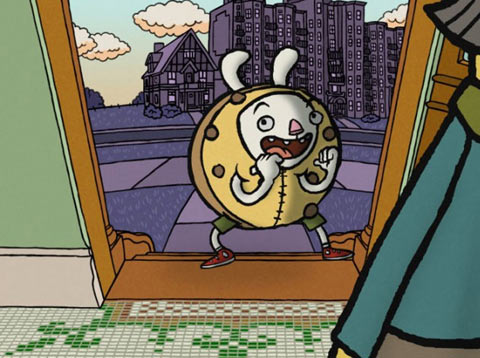
Are you planning to do anything with the concept now that it’s been dropped by Cartoon Network?
Fran: I really like this one. I’m proud. Cartoon Network does not own the rights to the characters, so we are trying to shop it around. If it does work out, however, the interested network would have to re-pay Cartoon Network for their development costs. That could get pricey. Really, I think this short represents our sensibility, what we’re capable of, and what we want to do. We have a few new pitches in the works which would be easier to produce, as there’s no legal red-tape, and we have proof that we can make a nice-lookin’ cartoon for a regular-cartoon budget.
Will: I learned from “Utica Cartoon” that we should consider our audience, and I learned from “The Upstate Four” that we should also consider how to make it easy for the development people to pitch our idea to other network/development people. Animators can get excited about animation, storytelling, sound and design, but our next pitch will probably have some sort of “hook” that will make it easy for a development person to sell it to someone who doesn’t know too much about animation.
I learned a lot about how I would like to make cartoons along the way, but now I’m ready for new characters in a new world. I was actually surprised at how soon after “The Upstate Four” was officially laid to rest that I was back to writing pitches and bouncing around new ideas with friends. I’m hoping that “The Upstate Four” will help to generate interest in new, quality cartoons that Fran and I could produce for a reasonable budget. (Yessir, feel free to contact us concerning the holes in your program schedule, those products yearning to be advertised with animation, and those songs you have which are unaccompanied by music videos.)
To learn more about their work, visit FranKrause.com and WillKrause.com. To see more stills from “Upstate Four,” GO HERE.

.png)